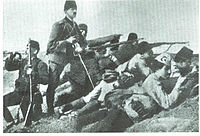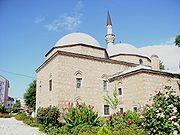- Macedonia under the Ottoman Empire
-
History of the
Republic of Macedonia
This article is part of a seriesChronological Ottoman Macedonia Karposh's Rebellion National awakening Ilinden Uprising Kruševo Republic Vardar Banovina National Liberation War Anti-Fascist Assembly (ASNOM) National Liberation Front Exodus from Northern Greece Socialist Republic of Macedonia 1963 Skopje earthquake Republic of Macedonia 2001 Insurgency in Macedonia Ohrid Agreement Topical Military history Demographics History of the Macedonian people Related Region of Macedonia Naming Dispute Public Holidays
Republic of Macedonia Portal
The territory of today's Republic of Macedonia was part of the Ottoman Empire for roughly five hundred years, from the late 14th century to 1912.[1][2]
Contents
History
Conquests
Further information: Rise of the Ottoman EmpireIn the Battle of Maritsa of 1371, the King of Prilep Vukašin Mrnjavčević and his brother Jovan Uglješa led 70,000 men against the Ottomans. Despite having smaller numbers, the Ottomans managed to kill Vukašin and his brother and win the battle.[3]
After falling under Ottoman rule, many mosques and other Islamic buildings, such as the Isa Bey Mosque, sprang up all over cities like Skopje
After the battle, most of Serbia broke into smaller principalities. One of those principalities is known as the Kingdom of Prilep, led by Vukašin's son Marko.[4] Like most regional rulers in Macedonia, Marko accepted vassalage under Sultan Murad I to preserve his position.
The Battle of Kosovo of 1389 sealed the fate of Macedonia for the next 500 years. While both armies lost leaders and large numbers of soldiers, the Ottomans could easily assemble another army just as large while the locals could not.
Marko died alongside Konstantin Dragaš at the Battle of Rovine in 1395.
All of Macedonia was under Ottoman control by the end of the 14th century, with Skopje falling under Turkish rule on January 19, 1392.[1][5]
Five hundred years of Ottoman rule
During the Ottoman rule of Macedonia, cities experienced many changes with regards to the demographic makeup of their population and the look of their cityscapes. With laws that prohibited Christian buildings from being higher than Islamic ones, the skylines of cities like Skopje and Bitola were dominated by minarets.[6]
Ottoman traveller Evliya Çelebi visited the city of Bitola in 1661. He wrote that of the seven mosques in the city at the time, six were built in the 16th century. Most of the mosques constructed in Macedonia were square in shape with a three-domed portico and a minaret on the building's right side.[7]
Macedonian cities under Ottoman rule
Balkan Wars
 Ottoman troops at the Battle of Kumanovo during the First Balkan War
Ottoman troops at the Battle of Kumanovo during the First Balkan War Main article: Balkan Wars
Main article: Balkan WarsThe Balkan Wars consisted of two wars that occurred in 1912 and 1913. The first began on 8 October 1912 when the nations of the Balkan League, who had large parts of their ethnic populations under Ottoman rule, attacked the Ottoman Empire. It lasted seven months with the Balkan League nations coming up victorious, ending 500 years of Ottoman rule in Macedonia and the Balkans.[1]
Administrative divisions
See also: Subdivisions of the Ottoman EmpireFrom the time that Macedonia first became part of the Ottoman Empire to the mid-19th century, it was located in the eyalet of Rumelia.
Vilayets
After adminstrative reform in 1860s, the Ottoman Empire was divided into vilayets which were subdivided into sanjaks.
Kosovo Vilayet
The northern part of the Republic of Macedonia was located in the Kosovo vilayet. Sanjaks located in this vilayet that contained territory now within Macedonia include:
- Sanjak of Üsküp, which included Skopje, Kumanova (Kumanovo), İştip (Štip), Kratova (Kratovo), and Koçana (Kočani)
- Sanjak of Prizren, which included Kalkandelen (Tetovo)
Monastir Vilayet
The southwestern part of the country was located in the Monastir vilayet. Sanjaks located in this vilayet that contained territory now within Macedonia include:
- Sanjak of Monastir, which included Bitola, Ohri (Ohrid), Resne (Resen), and Pirlepe (Prilep)
- Sanjak of Debre, which included Debar and Kiçevo (Kičevo)
Salonika Vilayet
The southeastern part of the Republic of Macedonia was located in the Salonika vilayet. Sanjaks located in this vilayet that contained territory now within Macedonia include:
- Sanjak of Selanik, which included Tikveş (Kavadarci), Usturumca (Strumica), Köprülü (Veles), Doyran (Dojran), and Gevgili (Gevgelija)
See also
References
- ^ a b c "Macedonia :: The Ottoman Empire". Britannica. 2010. http://www.britannica.com/EBchecked/topic/354223/Macedonia/42800/The-Ottoman-Empire?anchor=ref476755. Retrieved August 25, 2010.
- ^ "AN OUTLINE OF MACEDONIAN HISTORY FROM ANCIENT TIMES TO 1991". Embassy of the Republic of Macedonia London. 2010. http://www.macedonianembassy.org.uk/history.html. Retrieved August 25, 2010. "The period of expansion of medieval states on the Balkan and in Macedonia was followed by the occupation of the Ottoman Empire in the 14th century. Macedonia remained a part of the Ottoman Empire for 500 years, i.e. until 1912"
- ^ Sedlar, Jean W., East Central Europe in the Middle Ages, 1000-1500, (University of Washington Press, 1994), 385.
- ^ The last centuries of Byzantium, (1261-1453) by Donald MacGillivray Nicol
- ^ "A brief account of the history of Skopje". skopje.mk. 2010. http://www.skopje.mk/index.php?option=com_content&task=blogcategory&id=3&Itemid=18. Retrieved August 25, 2010. "A monk at the Saint Theodor Monastery on Mt. Vodno briefly recorded the date of the town's capture by the Turks: "In the 69th year (1392) the Turks took Skopje on the 6th day of the month (January 19, 1392 according to the new calendar)."
- ^ "The Church of St Spas - Skopje". National Tourism Portal of Macedonia. 2005-07. http://www.exploringmacedonia.com/?ItemID=60170837F99D7A4AAF93A56C3D280825. Retrieved August 27, 2010. "...half of it was constructed underground, due to the 17th century edict of the Turkish Sultan that prohibited Christian structures from being higher than mosques."
- ^ "The Sixteenth Century Mosques of Bitola / Toli Manastır1". Kalamus. 20??. http://www.kalamus.com.mk/pdf_spisanija/patrimonium_3/024%20-%2003%20Spisanie%202010%20Robert%20Mihajlovski%2001%20ok.pdf. Retrieved August 27, 2010.
External links
- The book on Marko Kraljevic - Marko, The King's Son - Hero of The Serbs by Clarence A. Manning, O. Muiriel Fuller, illustrated by Alexander Key
History of modern states under the Ottoman Empire Africa Asia Europe Albania · Bosnia and Herzegovina · Bulgaria · Greece · Hungary · Kosovo · Macedonia · Montenegro · SerbiaCategories:- Macedonia under the Ottoman Empire
- 1912 disestablishments
- History of the Ottoman Empire
Wikimedia Foundation. 2010.





